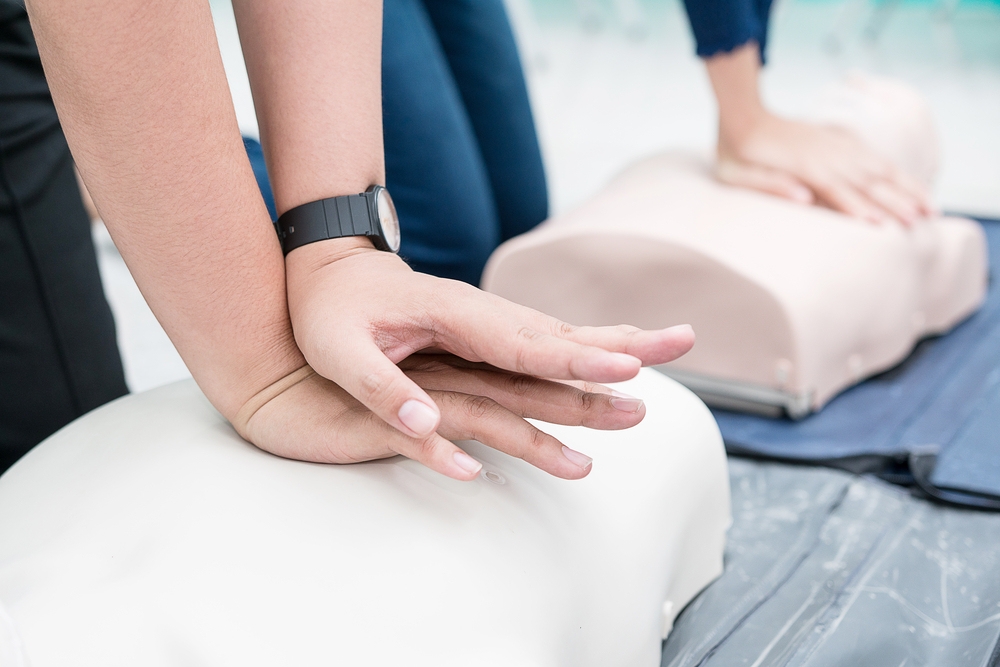
A famous large hospital in Beijing held a staff sports meeting. When entering the stadium, a young worker suddenly lost consciousness and fell to the ground.
Just as there were several emergency doctors at the stadium, they immediately recognized the cardiac arrest, started CPR and mouth-to-mouth artificial respiration, and called an ambulance from their own hospital. The ambulance arrived at the scene quickly, so the emergency doctors transferred the patient to the emergency department and emergency room while continuing CPR.
The order of first aid to the emergency is:
-
Establishment of bone marrow cavity infusion channel
-
Connect the ventilator through orotracheal intubation.
-
ECG monitoring indicated ventricular fibrillation and defibrillation was implemented.
Finally, the heart resumed beating.
There are a large number of experts involved in the rescue and a large number of departments involved in the mobilization. The treatment methods implemented include: chest compressions, ventilators, temporary pacemakers and extracorporeal membrane oxygenation (ECMO). It is said that the condition is stable at present.
The article was sent out by the hospital’s official WeChat, microblog and headline platforms, with great momentum. Of course, the end is: [The success of this rescue is another manifestation of the hospital’s ability to unite and cooperate with multiple departments and departments in dealing with emergencies.]
However, there seems to be something wrong…
Should how do medical insurance during sports?
Why is there no emergency support team for the whole hospital sports meeting?
During exercise, the most common injuries are heatstroke or hypothermia (depending on the weather), acute trauma, muscle spasm, strain, etc.
Therefore, it is necessary to prepare emergency support items accordingly:
- Heatstroke: ice water, oral rehydration salt, infusion complete set. Hypothermia: thermal blanket, glucose solution. Acute trauma, muscle injury: neck brace, spinal fixation stretcher, fracture splint, gauze dressing and other hemostatic bandaging articles, ice bag.
However, there are also frequent cardiac arrest with serious consequences in sports, such as the scene in the sports meeting of a large hospital above. Cardiac arrest must also be fully warned. Never say that taking a first aid kit and putting a few gauze and iodophor is even [having first aid protection].
In today’s frequent sudden death due to sports, if even hospitals do not have such vigilance and filing, it can be considered that organizers have not performed their duties.
In order to prevent possible cardiac arrest, at least these things are necessary: defibrillators (manual or automatic), infusion equipment, tracheal intubation. If conditions permit, portable ventilators, chest compressions, etc. can also be prepared.
Marathon races may be safer than hospitals.
Since the introduction of AED for the first time in the Guangzhou Marathon in 2014, many domestic marathons have completed the upgrade of first aid support in advance and after.
For example, the Guangzhou Marathon in 2015 achieved such a guarantee:
- One emergency volunteer every 100 meters, early identification found cardiac arrest, the first time to start cardiopulmonary resuscitation; One AED mobile rescuer every 1000 meters, riding a bicycle or motorcycle, can arrive at the onset site and defibrillate within 3 minutes. A total of 36 ambulances with transfer ventilators and cardiopulmonary resuscitation machines can arrive within 5 minutes and provide advanced life support.
This pre-hospital emergency configuration is the best explanation for the whole cardiac arrest [life chain]. Although not all of them are composed of professional doctors, the success rate of rescue may even be higher than that of cardiac arrest in hospital.
Because even in many hospitals, there is no guarantee that every corner can start pressing in 1 minute and defibrillation in 3 minutes.
There is no difference in general principles between in-hospital and out-of-hospital first aid.
In the early stage, in-hospital first aid and pre-hospital first aid also need to provide basic life support at the first time: the pressing speed is 100-120 times/minute, and the pressing depth is 5-6 cm, so that the thorax can fully rebound and the interruption of pressing can be reduced; Maintain the ratio of compression to artificial respiration (30: 2 when rescuing adults) to avoid hyperventilation; Electric shock defibrillation as soon as possible.
In the rescue of this hospital in Beijing, we did not see defibrillation immediately after the ambulance arrived. Even in the pictures inside the ambulance at the scene, we did not see artificial respiration using balloon mask or people managing respiratory tract. It was not until after returning to the hospital that defibrillation was carried out after opening the infusion channel and tracheal intubation.
Cardiac arrest and ventricular fibrillation are meaningful every minute and second of defibrillation. At this time, it is very lucky to be able to rescue successfully. Of course, the whole hospital has strong general mobilization ability, advanced equipment and all-out rescue is commendable.
However, having advanced life support equipment to escort is not a reason to ignore the most basic rescue principles. [Return to the hospital as soon as possible] is right, but more attention must be paid to the rescue links on site and in ambulances-this is the best chance for rescue.
In a word
It is not that one can save people from cardiac arrest without preparation by mastering professional first aid knowledge.
Whether it is a well-equipped hospital, a pre-guaranteed sports venue, or a subway or airport in daily life, starting cardiopulmonary resuscitation and defibrillation in the first place is the most important thing to remember. As a professional doctor, you need to know the importance of defibrillation.
First aid, not only need to know, but also can be done correctly, in order to bring hope to patients to the greatest extent.
Copyright of Clove Garden. No reprinting is allowed without permission.
